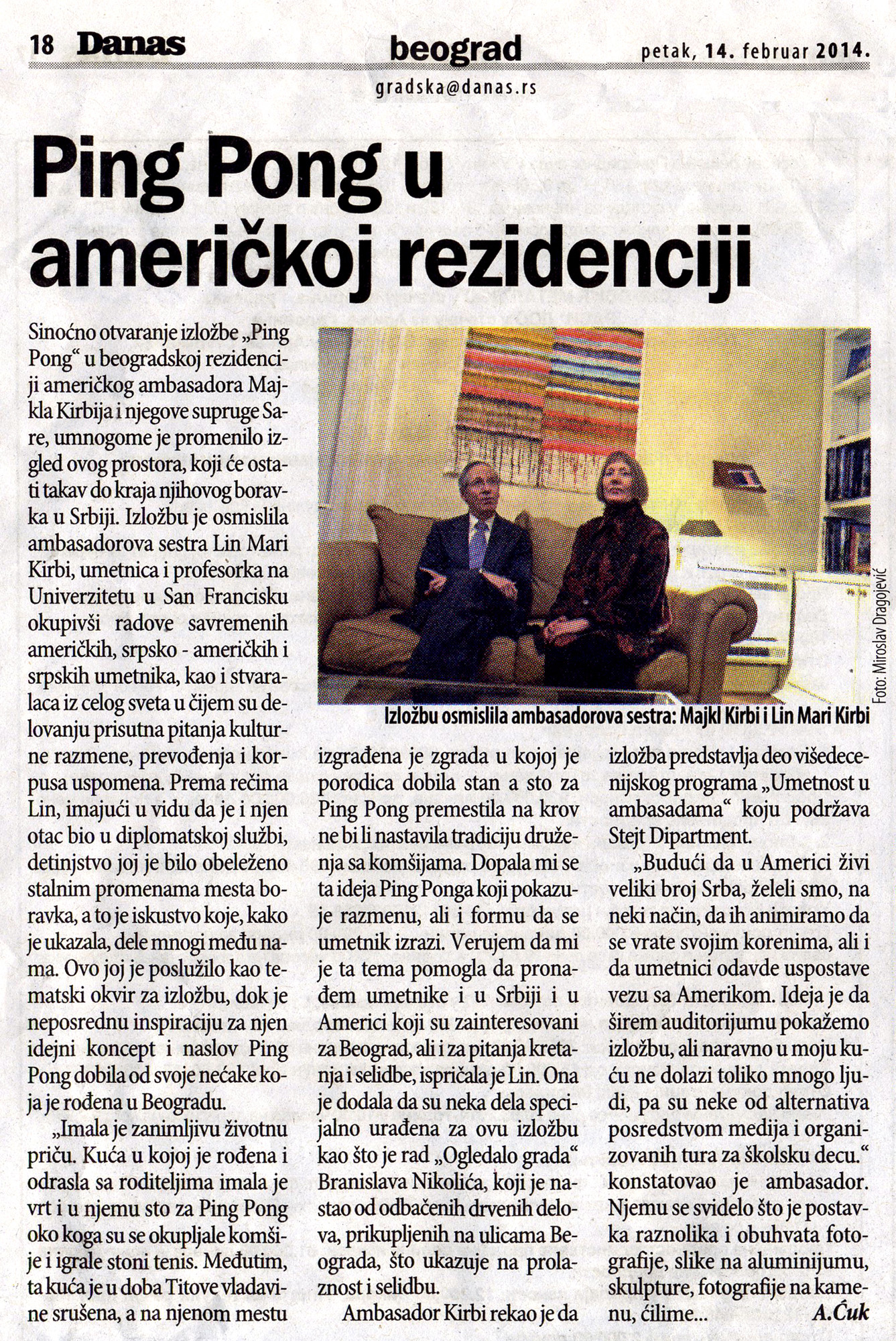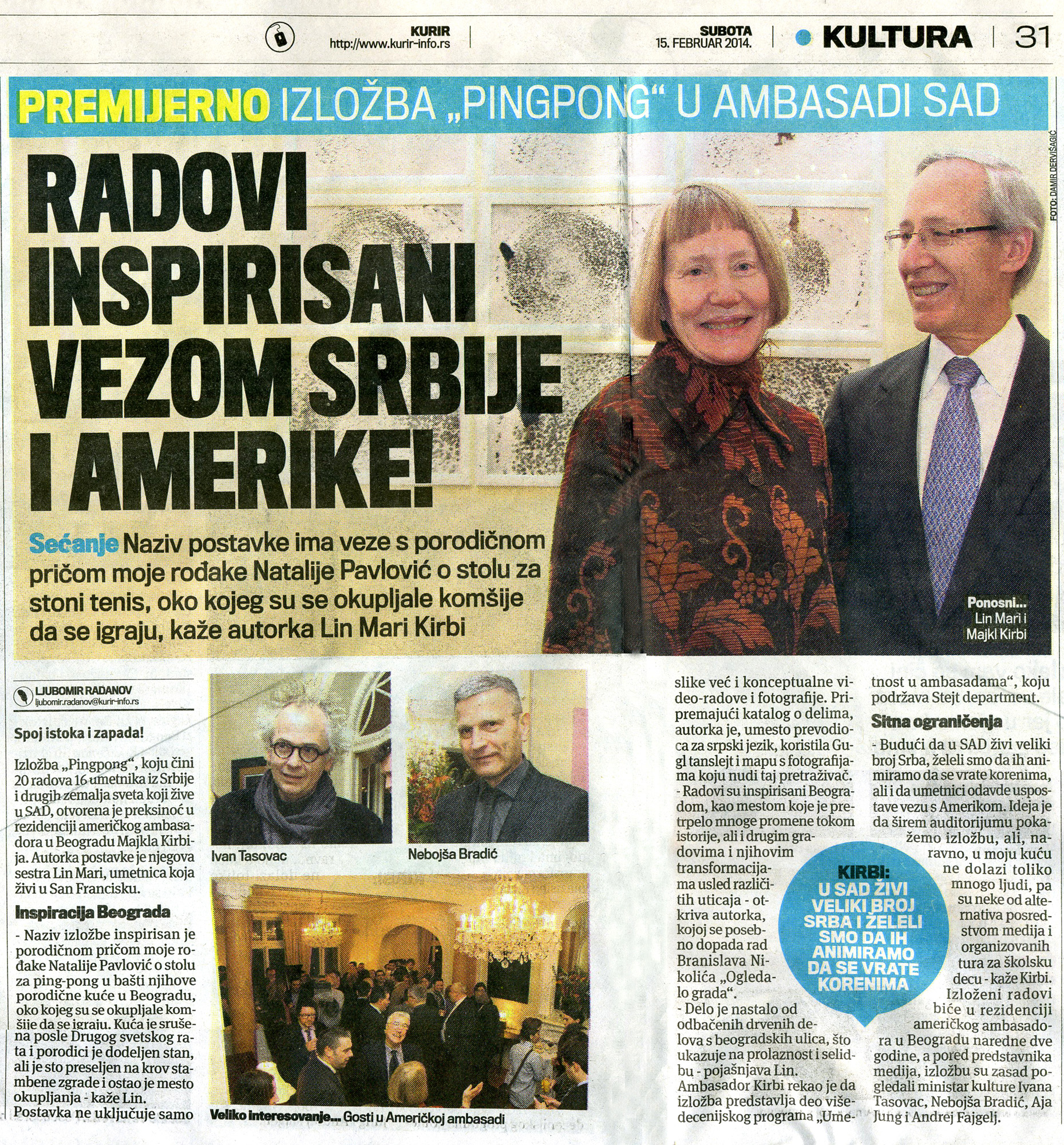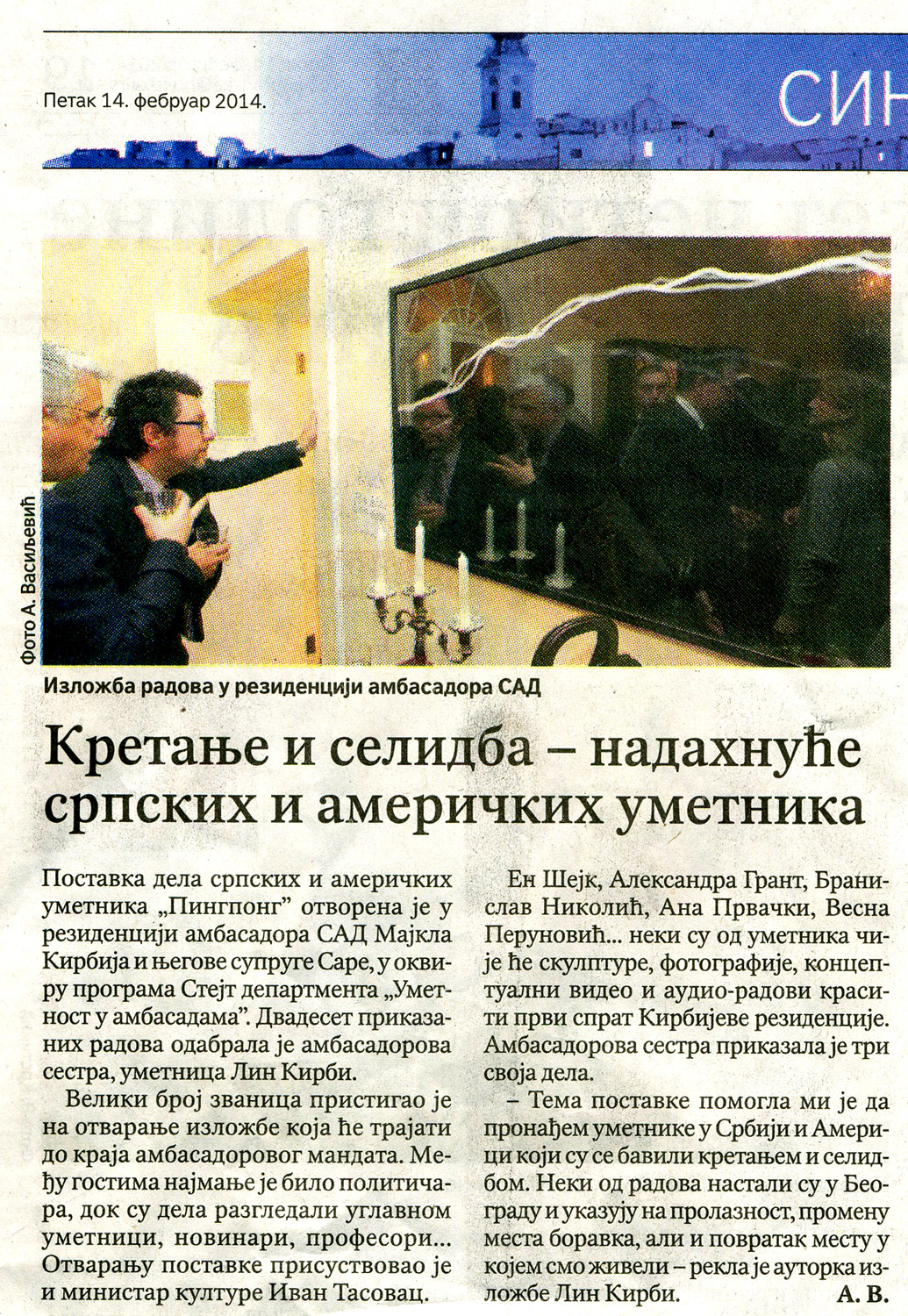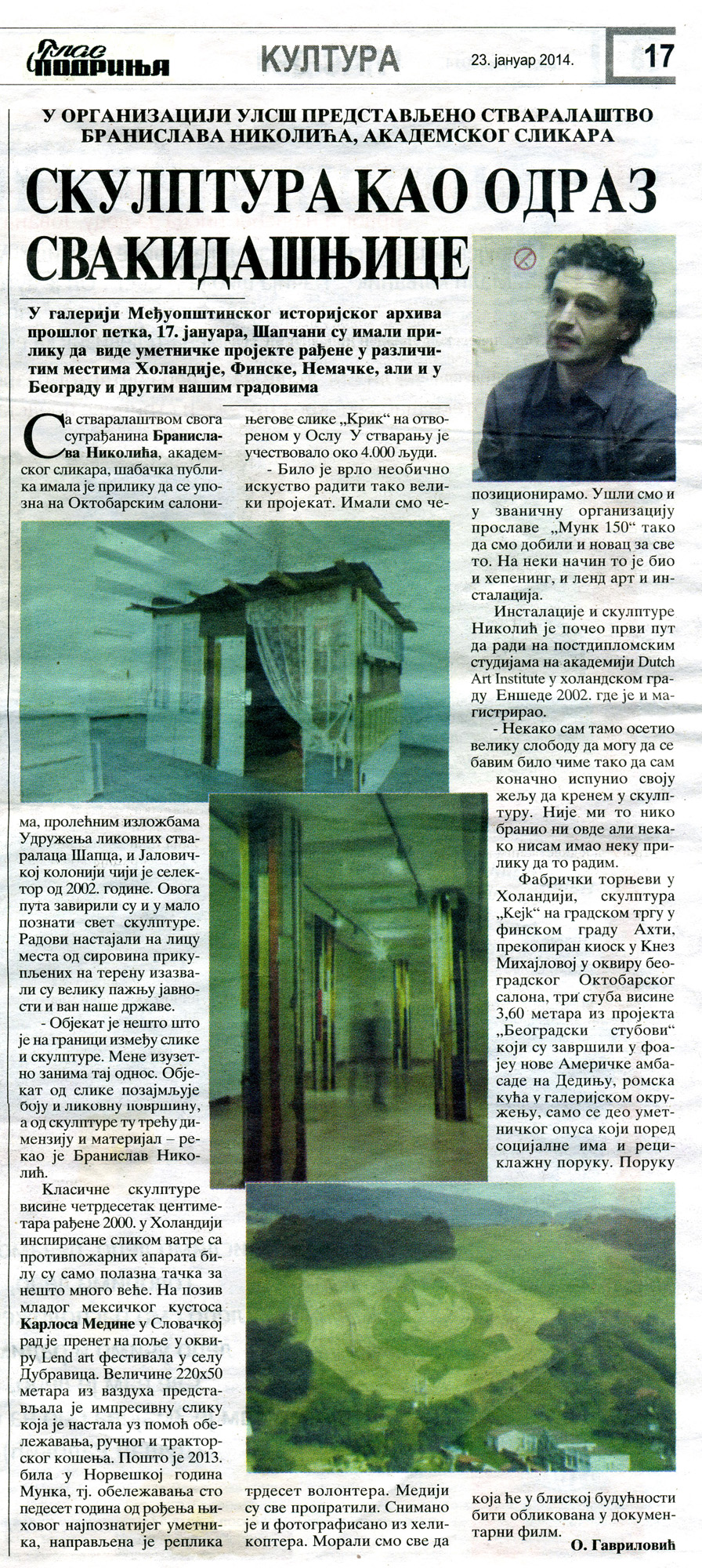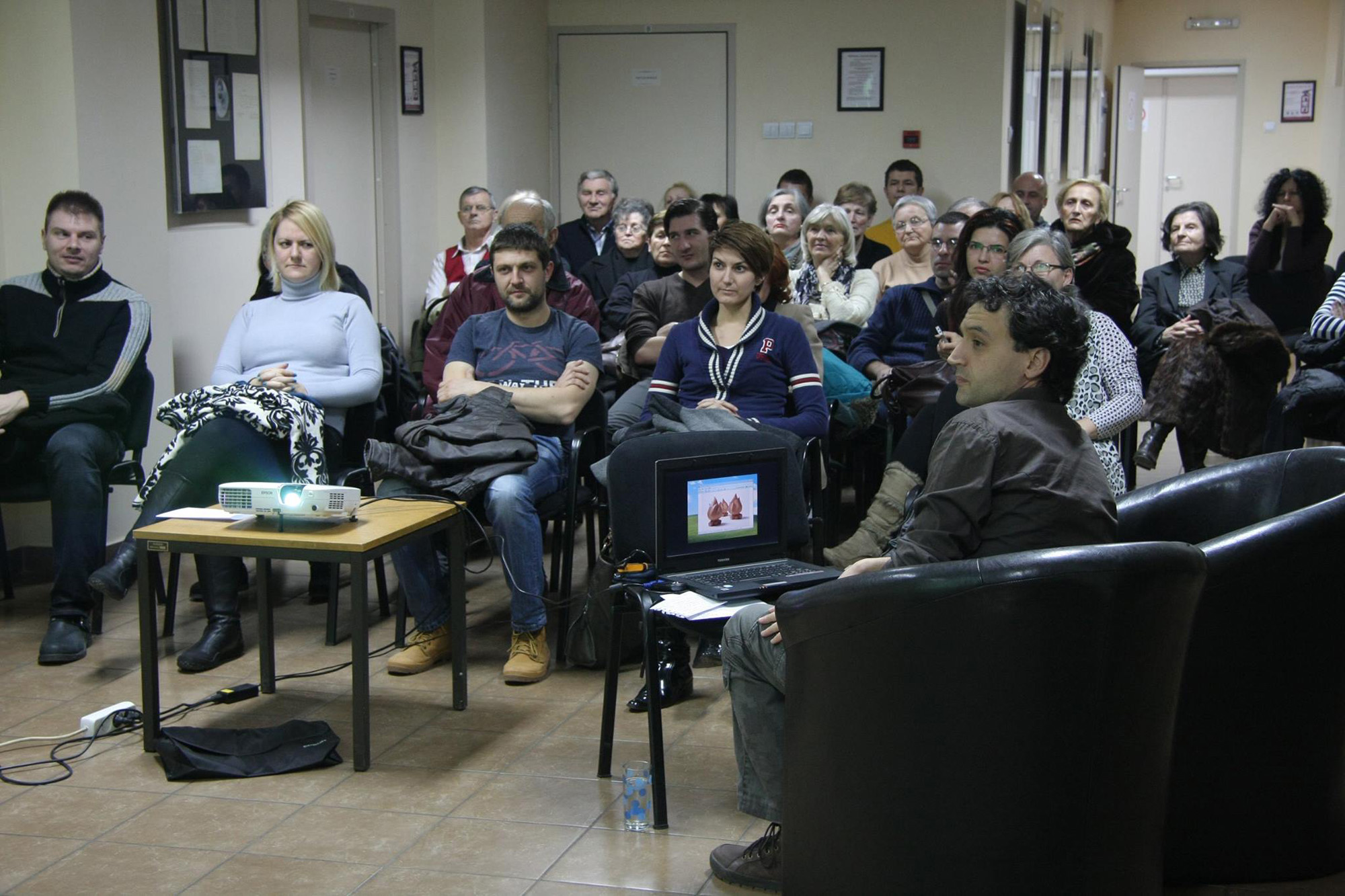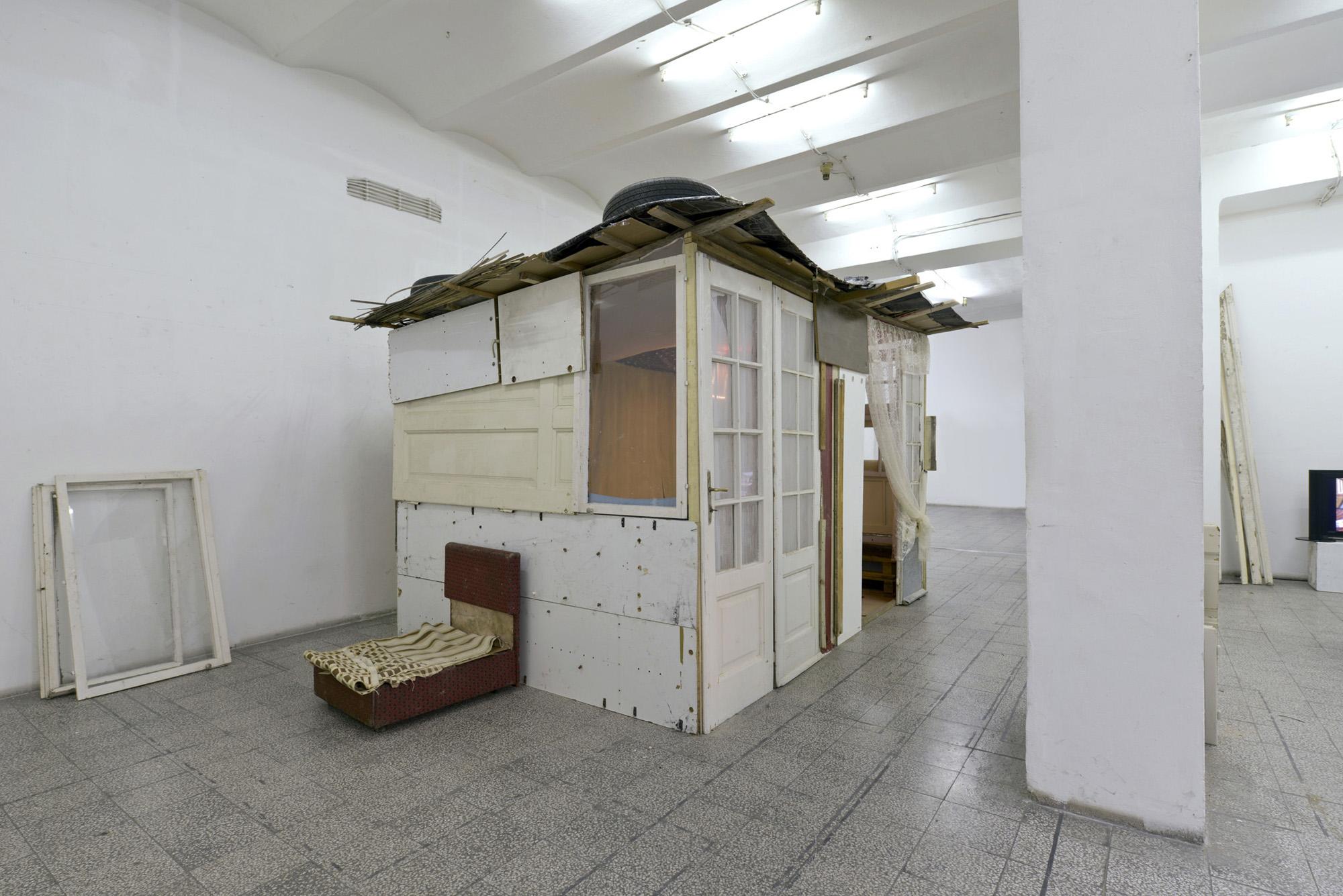Aleksandar Jestrović Jamesdin, Bez naziva, 2007
Kada budete svraćali do Merkatora, Bulevarom umetnosti – pravcem iz centra, u želji da nadoknadite propušteno, možda naletite na skulpturu IN/OUT. Uzalud ćete tražiti legendu o autoru, nije po-stavljena. Brdo problema oko toga je bilo, ali mi nismo tužakala. Pravio ju je Branislav Nikolić (a koliko znam, pomagao mu je dosta čale, također umetnik, oko kalupa i izlivanja). To je jedna od retkih skulptura koje se nalaze u javnom prostoru NBG-a, koja je postavljena posle revolucije i koja ima veze sa savremenom umetnošću. U stvari, ja ne znam ni za jednu drugu. Mada u čaršiji kolaju priče da će se u najskorije vreme raspisati konkurs grada u saradnji sa jakim firmama za predloge skulptura ispred banaka i tržnih centara. Biće za umetnike ispod 35, tako da ću ja možda i stići, ali ti si B. N. prestario.
Betonska slova od kojih se sastoji gorepomenuta skulptura, čini mi se, mnogo govore o vremenu u kojem živimo i, što se mene tiče, ovaj rad je jedne godine IN a druge OUT. U zavisnosti od mode na listi IN/OUT se mogu naći i teme drugih skulptura i crteža koje ovaj umetnik radi. Navodim neke kojih se sećam, a to su: torte, gume (automobilske), kokosovi orasi, televizori, sakoi, kiosci & crkve, prozori, planete i mirisne jelkice…
Takav slobodan prilaz temama i skulptorska obrada izvedena iz pop-art, trash i minimalističkih postupaka dozvoljavaju da o njima mislite šta hoćete, a estetsko zadovoljstvo i komunikacija sa ovim delima zavisiće od vaših kapaciteta i znanja. Drugi kvalitet ovih radova je svest o recikliranju materijala, koja je deo savremenih tendencija i postupaka koje je ovaj umetnik usvojio na školovanju u Holandiji. Takav postupak i pristup materijalima u našim uslovima ima dodatni smisao jer omogućava lakše eksperimentisanje i uvećava svest o formama i objektima koji nas okružuju. Da to nije čest slučaj ovde, mogu da potvrdim, jer sam bio svedok razgovora naših mladih kustosa koji su bili na nekom sajmu savremene ume-tnosti u inostranstvu i žalili su se da ne kapiraju zašto kolekcionari kupuju neke „gluposti” od kartona i dasaka.
Moram da se zahvalim B. Nikoliću što me je promovisao u maneke-na na modnoj reviji i performansu grupe New Remote, čiji je član, i čiji rad smatram interesantnim. Tu sam upoznao jedinu Indijku u svom životu (Camilla Singh) i proveo par nezaboravnih momenata u društvu Mis Yu – samo u donjem vešu.
Izvini što sam ti slupao jednu vatricu, bolele su me ruke, ceo dan sam istovarao gajbe piva na Sex i gradu.
Aleksandar Jestrović Jamesdin, Untitled, 2007
When you come by to Mercator shopping mall, down Boulevard Umetnosti coming from the centre, wishing to compensate for the loss, maybe you will stumble up the IN/OUT sculpture. You will search in vain for the data on the author. It’s not there. There were numerous problems about it but we are no telltalers. It was made by Branislav Nikolić (and, as far as I know, his dad, also an artist, helped him with the mould and casting). That is one of few sculptures that you can find in Novi Beograd public space, which was installed after the revolution and which has to do with contemporary art. Actually, I know of no other. Although rumour has it that very soon a competition will be announced on the city level in cooperation with big companies for the proposals for sculptures placed in front of banks and shopping malls. It will be for the artists younger than 35 years of age, so maybe I will make it, but, B.N., you are too old now.
The concrete letters that the above mentioned sculpture consists of, say a lot, it seems to me, about the time we live in and, as far as I am concerned, this piece of work is year IN, year OUT. Depending on the IN/OUT list and the vogue of the moment one can find topics of other sculptures and drawings this artist has created. I am mentioning the ones I remember and they are: cakes, tyres, coconuts, TVs, jackets, kiosks & churches, windows, planets and Wunderbaum trees.
Such a free approach to topics and sculptural work derived from pop-art, trash and minimalist procedures allow you to think of them what you will and the visual pleasure and communication with these pieces of art will depend on your capacities and knowledge. Another quality of these pieces is the awareness of material recycling, which is a part of modern tendencies and actions that this artist has adopted during his studies in Holland. Such a method and approach to the materials in our condition makes additional sense because it allows easier experimenting and increases the awareness about the forms and objects that surround us. I can confirm that it is not often the case here, because I was myself witnessing a discussion among our young curators who were at a contemporary art fair abroad complaining that they did not get it why the collectors buy some “rubbish” made of cardboard and planks.
I have to thank B. Nikolić for promoting me into a model at a fashion show and performance of the New Remote group whose member he is and whose work I find very interesting. I met the only Indian woman in my life there (Camilla Singh) and spent a couple of unforgettable moments with Miss YU – just in our underwear.
I am sorry for breaking one of your little fires – my hands ached. I have been unloading beer boxes in Sex and the City Bar.
Kosta Bogdanović, Nova iskustva viđenja i predstavljanja, 2007
I
Na relaciji činilaca zakona verovatnoće (jednako–nejednako–slično) prenetih u vizuelnu kulturu, termin slično ima primetne posledice u oblasti umetnosti na osnovu kojih se novija umetnost znatno razlikuje u odnosu na klasičnu. Pojam slično je poredbeni posrednik, kako među pojmovima jednako i nejednako tako i u domenu samog pojma slično, kao odnos u poređenju nečega prema nečemu ili nekoga prema nekome. Kao što su u klasičnoj umetnosti sve do kraja 19. veka motivi proizlazili iz prirodnih formi, tako je umetnost 20. i 21. veka više upućena na sebe kao predmet. Slično se manifestuje zadatim odrednicama i determinantama novih tehničko-tehnoloških obeležja, svojstava i standarda, putem kojih se već masovno ostvaruje savremeno umetničko delo. Time se pojam slično u delima koja su ostvarena pod istim tehničkim uslovima stilski unifikuje a poetički individualizuje. Tako se slično i sličnost u savremenom umetničkom delu tipološki veoma približavaju, bez obzira na individualne predstave, dimenzije, tehnike. Na takav način vizuelne ume-tnosti sasvim određeno „pozajmljuju” virtuelitet sličnosti od prirodnih i opredmećenih oblika, sa vrlo malo učešća neposrednog stvaraoca tokom procesa nastanka dela. To ne umanjuje značaj i umetnički doseg savremenog dela, ali multiplikovanje sličnog vodi ka ano-nimnoj formi. Znatan deo takve vrste umetničke produkcije ostaje samo u tragovima zapamćivanja i umanjuje autentičnost dela.
U tom smislu pojam slično dostiže jedinstvo u standardima tehničkog izvođenja, gde pojam i značenje autentično skoro da gubi primat u odnosu na zahteve permanentnog moderniteta. Time se tehnički na nov način otvaraju putevi drukčijem viđenju već poznatog.
S druge strane, onaj drugi deo u produkciji dela savremene umetnosti koji proističe iz potrebe naznačavanja „ličnog pečata” u produkciji dela savremene umetnosti, kojom se afirmišu autentična nastojanja „strogo personalnog znaka” (što se bitno vezuje za pojam i značenje umetničkih sloboda koje je umetnost 20. veka tako burno osvajala), više se približava opštem pojmu nejednako (kao gest razlikovanja od drugih), pri čemu se svakako veruje u postignuće autentičnosti i na prvi pogled personalizovanog stava prema shvatanju sopstvene umetnosti. Koliko god, u prvom slučaju, savremena tehnika i tehnologija medijski unifikuju umetničku produkciju, vezujući se za dominantnost pojma slično, toliko u ovoj drugoj oblasti dominira
pojam nejednako u njegovim najširim značenjima.
II
U širem kontekstu značenja slično nalazimo važnu stavku poetike umetnosti Branislava Nikolića. To se posebno odnosi na skulpturalne objekte koji su namenjeni otvorenom prostoru, čija se objektno-prostorna i funkcionalna datost svojom pojavnošću bitno vezuje za sličnost sa nečim veoma poznatim. To nisu simbolizovani atributi „portretisanih oblika stvarnosti” već samosvojni pristup emancipaciji njihovog konvencionalnog banaliteta. Zapravo, to je demonstracija htenja ovog autora koji ne želi skoro ništa drugo osim da veoma poznatom obliku stvori novi prizor u kojem on dobija na silini svoje već očigledne prepoznatljivosti. Tako svaki oblik „zaslužuje” svoju umetničku reinterpretativnu prezentnost u kojoj on više nikada neće biti ono od čega je pomišljen da postoji. To je prefinjeni iskorak ispod Dišanovog „šinjela” od kojeg ne proističe samo preimenovanje funkcije bivšeg konvencionalno-funkcionalnog predmeta ka njegovoj „profanoj sakralizaciji”. Branislav Nikolić se bitno oslanja na suštinsko kretanje spoljne konture preoblikovanog objekta, čime ne narušava lik izvornog modela, već do kristalne jasnoće ističe oblik ogolele pojavnosti u elementarnim svojstvima materijalizovane forme. Najčešće koristi odbačen ili već upotrebljen materijal. U tom smislu pojam slično novoopredmećenog objekta, u značenju skulpturalna forma, u delima Branislava Nikolića uspostavlja novu konvenciju prepoznavanja skulpturalnosti u odnosu na ugledanje na „sličan” već postojeći objekat. Estetika i poetika njegovih skulptovanih objekata (crkva, stub, keramički krug, kolač), ili objekti instalacije u vidu TV ekrana zalivenih u betonske mase, ili oblici koji predstavljaju „trash estetiku”, kako o tome i sam govori, u stvari vaskrsavaju jedan skoro neprimetljivi svet formi i materijala, koji tek u skulptorskim intervencijama, kao prekomponovani objekti, dobijaju status visokoemancipovanih skulptovanih objekata.
U tim okolnostima promišljanja skulptorskih i instalacijskih mogućnosti, ovaj autor na izrazito savremen način povezuje i objedinjuje načela vizuelne kulture sa načelima ekološke svesti i aktuelnom reciklažom. Tako ovaj umetnik urbane orijentacije, na jedan veoma jednostavan način trasira put ka autentičnom stvaralačkom procesu, u kojem nije opterećen nikakvim trenutnim i prolaznim efektima, gde svoju umetnost neguje u skladu sa svojom ličnošću ozbiljnog, radoznalog, sklonog učenju, mirnog čoveka.
Na to najbolje ukazuje jedan od njegovih radova pod nazivom IN/OUT (skulptura oblikovana od slovnih znakova pomenute dve reči), izveden 2003. godine u okviru BELEFa, ispred tržnog centra Merkator u Beogradu. Slova izlivena od betona (150 x 100 cm svako) položena su u ravni tla u dva nivoa i svojim značenjem ukazuju na znatno širi kontekst, predstavljajući time i prve korake ka shvatanju urbane skulpture u Beogradu, namenjene, dakle, samoj urbanoj strukturi grada, lišene svake konvencionalno-spomeničke uloge.
Uz sve to, potrebno je pomenuti i njegov veoma zanimljiv crtački opus u vidu svakodnevnih beleženja pojedinih oblika i ideja koji negde, za „ostali svet”, ostaju skoro neprimetljivi. To svakako ima direktne veze sa njegovim istraživačkim radom u oblasti vizuelne kulture, kao i sa pasioniranim prikupljanjem materijala za tu oblast putem crtanja, fotografisanja, isecanja iz štampe i pretraživanja na Internetu.
Branislav Nikolić je i koautor u pisanju udžbenika za likovnu kulturu od prvog do četvrtog razreda osnovne škole.
Pominjanje ovih sklonosti i aktivnosti Branislava Nikolića nije samo puko upoznavanje sa njegovim javnim radom, nego je ovde mnogo značajnije isticanje jednog novog profila umetnika, koji radi i druge poslove svakodnevno, ali koji upravo zato i tako može savremeno da profiliše svoj svet umetnosti.
Kosta Bogdanović, New Experiences of Seeing and Presenting, 2007
I
In the relation of factors of probability (equal – unequal – similar) transformed into visual culture, the term similar has obvious consequences in the field of art based on which the new art is considerably different form the classical art. The term similar is a comparison mediator, both between the terms equal and unequal and in the domain of the term similar, as a relation in contrasting something to something else or someone to someone else. As in the classical art, until the end of the 19th century motives came from natural forms, so is the art of the 20th and 21st centuries focused more on itself as an object. Similar is manifested through the given frames of reference and determinants of new technical and technological signifiers, capacities and standards, by which a contemporary work of art is massively realised. Due to that the term similar in works that are realised under the same technical conditions is unified in style but individualised poetically. And so similar and similarity in contemporary works of art are quite close as types, regardless of individual concepts, dimensions and techniques. In this way visual arts absolutely concretely “borrow” virtual quality of similarity from the natural and embodied shapes, almost without participation of the direct creator during the process of creating the piece. This does not belittle the importance and artistic range of a contemporary work of art, but multiplying the similar leads toward the anonymous form. An important part of such kind of art production remains only in traces of remembering and reduces the authenti-city of a work of art.
In that sense the term similar achieves unity in the standards of technical performance where the term and the meaning of the term authentic almost lose priority in connection to the requirements of permanent modernity. Technicaly, new roads are thus open towards seeing the familiar in a different way.
On the other hand, the other part in the production of the work of contemporary art that emerges from the need of emphasizing a “personal touch” in the production of contemporary works of art, which promote authentic attempts of a “strictly personal signature” (which is importantly connected to the term and meaning of art freedom, so tempestuously conquered by the art of the twentieth century), is approaching more to the general term unequal (as a gesture of differing from others), for that, one by all means believes in achieving authenticity and, what seems, a personalised opinion regarding understanding one’s own art. As much as, in the first case, modern techniques and technologies unify the art production in a media way, adjoining itself to the dominance of the term similar, in the same ratio, the other field is dominated by the term unequal in its widest meanings.
II
In a wider context of the meaning of similar we find an important poetic segment in the art of Branislav Nikolić. This is especially connected to the sculptural objects intended for public spaces, whose objective-spatial and functional offering is in its appearance quite importantly connected to the similarity to something very well-known. Those are not symbolised attributes of the “portrayed shapes of reality”, but present a self-determined approach to the emancipation of their conventional banality. Actually, it is a demonstration of the author’s desires to create a new show where he wins the power of his already obvious recognisability. Thus, each shape “deserves” its own re-interpretative presentation where it will never be what it was thought to have been. It is a refined step forward from Duchamp’s “army coat” and it is not just the source of just renaming the function of a former conventional-functional object towards its “profane sacralisation”. Branislav Nikolić leans on the essential movement of the outer contour of a reshaped object, not annihilating the feature of the source model, but with crystal clarity pointing out the naked appearance in elementary characteristics of materialised form. Very often he uses a discarded object or one that has already been used. In that sense the term similar of that newly-made object, indicating a sculptural form, in Branislav Nikolić’s work establishes a new convention of recognision of sculptural in relation to taking example by a “similar” already existing object. Aesthetics and poetry of his sculpted objects (church, pillar, ceramic circle, cake), or objects-installations seen in TV commercials cast in concrete, or shapes that represent “trash aesthetics”, as he himself says, actually resurrect an almost invisible world of forms and materials, which only in sculptors’ interventions, as re-composed objects, are given a status of highly emancipated sculpted objects.
In these circumstances of reflexion upon sculpting and installation capacities, this author connects and engulfs the contemporary principles of visual culture with the principles of environmental awareness and recycling. As an artist of urban orientation he makes a simple path towards a creative process, not bearing a burden of instant and passing effects, where he cherishes his art in coordination with his personality of a serious, curious, quiet man ready to learn.
The best example for this is one of his works called IN/OUT (a sculpture containing the two words), exhibited within BELEF in 2003, in front of Mercator mall in Belgrade. The letters cast in concrete (150 x 100 cm each) are levelled with the ground but at different heights, pointing out to a much wider context, thus presenting the first steps towards understanding urban sculpture in Belgrade, intended for the very urban structure of the city, stripped of any conventional/monument-like role.
Apart from all this, it is necessary to mention his very interesting drawing opus that has emerged during his daily recording of certain shapes and ideas that somehow remain invisible for the “rest of the world”. This is directly connected to his research work in the field of visual culture, and with the passionate collecting of the materials for this activity through drawing, photographing, cutting out newspaper articles and surfing the Internet.
Branislav Nikolić is the co-author of the textbook for art culture from the first to the fourth grades of elementary school. Mentioning these interests and activities is not a mere introduction to his public work, but it is a lot more important to point out a new profile of an artist who does other things on a daily basis, but who can therefore profile his world of art in a modern way.

